SOLD
End of 19th Century Antique Natural Indigo & Iron-mordant Dyed Hand Woven Pure French Linen Made Hunting Jacket
今なお世界のリネン繊維の原料のフラックス(亜麻)の70%以上を生み出し続けるフランスは、文字通りのリネン大国です。
France is literally a linen powerhouse as it continues to produce more than 70% of the world’s flux (flax) for linen fiber.


19世紀末に、フランスで栽培し、繊維として加工され、糸として紡績され、手動織機で織られたリネンのアンティーク生地を使ったハンティングジャケットです。
This Hunting Jacket is made of antique linen fabric that was grown, processed as fiber, spun into yarn, and woven on a manual loom in France at the end of the 19th century.
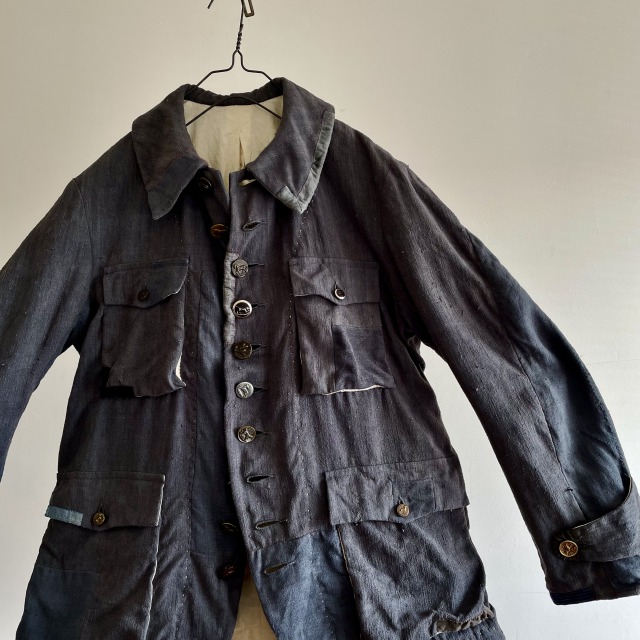

緩めの手紡ぎっぽさのある素朴な質感の糸。リネンという名前の持つ上質や高級なイメージといった一面とは対極にある骨太で野性味のあるはだかのリネン。
The yarn has a rustic texture with a loose, hand-spun feel. It is a bare linen that is thick and wild, which is the opposite of the image of high quality and luxury that the name “linen” implies.


その生地を農民などがおそらく自分達で手染めしたのでは無いかと思われる、素朴なインディゴ染にさらに南フランス地方の染色技法の鉄媒染を行なった深い色合い。
The fabric was dyed by hand, probably by farmers themselves, with a simple indigo dyeing technique and a deep color made with iron mordant, a dyeing technique from the south of France.


インディゴ染は当時は、今のようなファッションからの要求とは無縁の生活に根差した存在。汚れ隠し、虫除けといった実質的な必要に対して、火にかけられる大きな釜などの特別な設備がなくても、家にある桶を使って常温で染める事が出来、小規模な染色にも適した便利な手法だったインディゴ染め。
At that time, indigo dyeing was a way of life that had nothing to do with the demands of fashion as we know it today. Indigo dyeing was a convenient method that was suitable for small-scale dyeing, as it could be done at room temperature using a tub at home, without special equipment such as a large pot that could be set on fire, for practical needs such as hiding stains and repelling insects.


ヨーロッパのインディゴ染色は、15世紀頃まではウォードという植物による独自の藍染め方法がありました。その後バスコ・ダ・ガマのインド航路の開拓以来、インド藍がインドから輸入されるようになると、値段や染色性、発色の良さからウォードは廃れ、インド藍に置き換えられてしまいました。
Indigo dyeing in Europe had its own indigo dyeing method using a plant called woad until around the 15th century. Later, when indigo was imported from India after Vasco da Gama opened the Indian trade route, woad became obsolete due to its price, dyeability, and coloration, and was replaced by indigo.


その後普及していく合成インディゴの開発は、1900年初頭以降。この生地が作られた19世紀末頃は、まだ天然のインド藍による藍染めリネンが作られていた時代と考えられます。
The development of synthetic indigo, which became widespread after that, was after the early 1900s. It is thought that indigo-dyed linen using natural Indian indigo was still being produced around the end of the 19th century when this fabric was made.


そのインディゴ染の色落ちを抑え、堅牢度をたかるための鉄媒染。グレーがかった深く藍色と手染めの素朴な風合いが生地の存在感を際立たせています。
Iron mordant dyeing is used to suppress the color fading of the indigo dyeing and to increase the colorfastness. The deep indigo color with a hint of gray and the rustic texture of hand-dyeing make the fabric stand out.


モチーフにしたのは、まだハンティングが高級な趣味だった時代のハンティングジャケット。高機能と高性能を追い求め、化学繊維とファスナーとvelcroで構成された現代のハンティングウェアが捨て去ったものが、たくさん残っていた頃のジャケットです。
The motif is a hunting jacket from a time when hunting was still a luxury hobby. This is a jacket from a time when the pursuit of high functionality and high performance left behind many of the things that modern hunting wear, composed of synthetic fibers, zippers and velcro, has discarded.
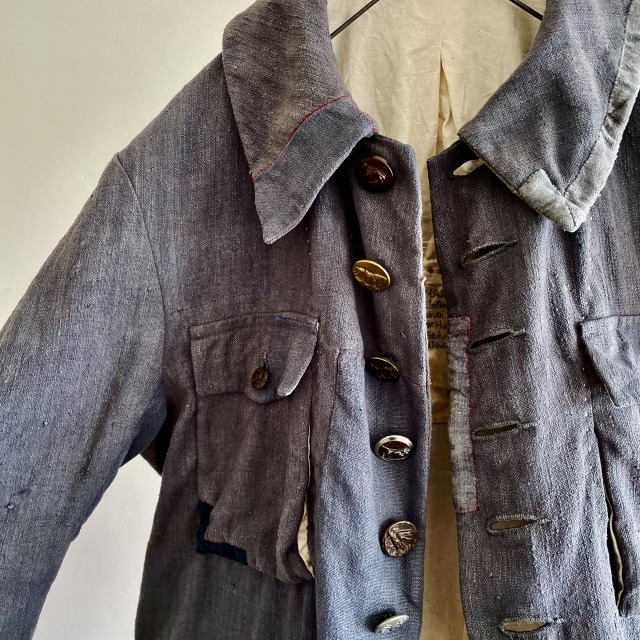

ジビエの季節とはまた違った、いわばハンティングのオフシーズンとも言える春や秋の季節に向けてのリネン生地のジャケット。まだ素朴さが残る手動織機の生地は、古いリネン特有の柔らかさと張りと力強さを持っています。
This linen jacket is for the spring and fall seasons, which are different from the gibier season, or the off-season for hunting, so to speak. The fabric is made on a manual loom that still has a rustic look, and has the softness, tension, and strength characteristic of old linen.


Vintageボタンの中でも1番人気が高く、1つがビッグマック2個分ぐらいが相場のフランスのハンティングジャケットに使われていたボタン。あえて様々な素材と、いろんな動物のモチーフをランダムに選んで縫い付けています。
The most popular of all Vintage buttons, these buttons were used on French hunting jackets, where one button was equivalent to two Big Macs. A variety of materials and animal motifs are randomly selected and sewn on.

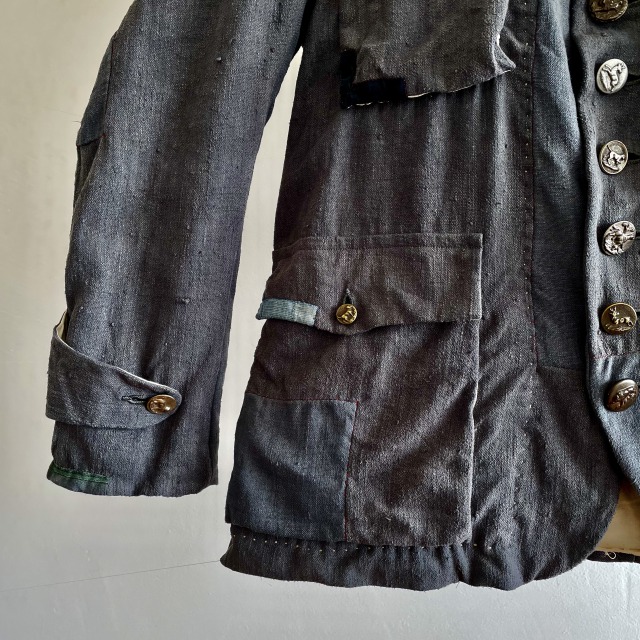
間隔を詰めて普通の2倍の数のボタンが並ぶインパクトのある顔つき。
It has a face with an impact, with twice as many buttons lined up at intervals as normal.


少し塗装が剥がれたり、色のくすみがあったりするボタンには、長い時間の痕跡が刻み込まれています。
The buttons, with their slightly peeling paint and dull colors, are imprinted with the traces of a long time.


ラウンドしたフラットなパターンで、少し大きめの襟の表情は、フランスのヴィンテージならではの独特の雰囲気が漂います。裏襟は細かなステッチを入れたインディアインク染めのアンティークリネンです。
The round, flat pattern and the slightly larger collar give the look of a unique French vintage. The back collar is India ink-dyed antique linen with fine stitching.


フランスの古い仕立てのジャケットによく用いられる、背中側に流れる肩線の仕立て。肩の部分がバイアス生地使いのようになり、肩への沿いが良く、動きやすくなるとともに、柔らかな印象の肩になります。前身頃も着た時に立体的な膨らみをうむ、ゆるい曲線を描くヘムになっています。
This is a tailoring technique often used in old French tailoring jackets, where the shoulder line runs down the back. The shoulders are made of a bias fabric, which makes it easier to move and gives a softer look to the shoulders. The front of the garment also has a loosely curved hem that creates a three-dimensional bulge when worn.


上から生地をのせてpatchするのではなく、象嵌細工のように生地をくり抜きながらモザイク状に生地をpatchしていくフランス独特のpatch work=travail de patchで描き出した象嵌模様。
The inlaid pattern is drawn by the unique French patch work = travail de patch, where the fabric is patched in a mosaic pattern while hollowing out the fabric like inlaid work, instead of patching the damage by putting the fabric on top.


丸いフォルムと膨らみが味のある内ポケット。
The round shape and bulge of the inner pocket are tasteful.


腕の形に沿って曲線を描く袖。テーラードの基本に則った立体的なパターンで仕立てられたジャケットは、ハンティングの為につくられた機能性だけではなく、フランスのエスプリ精神と美しさと力強さに溢れています。
Sleeves that curve along the shape of the arm. The jacket, tailored in a three-dimensional pattern that follows the basics of tailoring, not only has the functionality of being made for hunting, but is also full of the spirit of French esprit, beauty, and strength.


裏をつけて2重にしたうえで、内側を手で掬い縫いして身頃に縫い付ける事で、ふくよかな質感のあるフォルムにしたポケット。
The pockets are lined and double-layered, and the inside is scooped and sewn to the body by hand to create plump, textured form.


背中の肩の辺りに入れた十字のステッチ。フランスのヴィンテージのリネンコードです。
Criss-cross stitching on the back, around the shoulders. This is a vintage French linen cord.
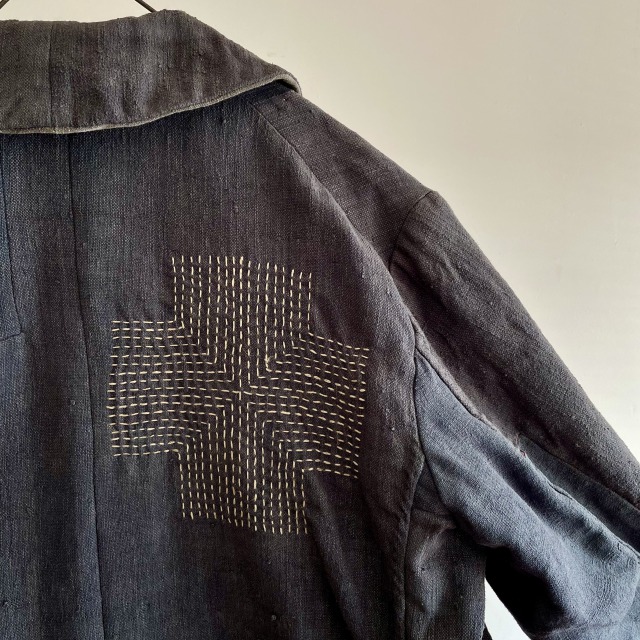

アンティークの生地ならではの生地の傷んだ部分や欠損の補修と、魅せるアクセントのためのpatch。patchに使ったのも、アンティークのインディゴリネン生地。
Used an antique indigo linen fabric for the patch to repair the damaged and missing parts of the fabric and to accent the piece.
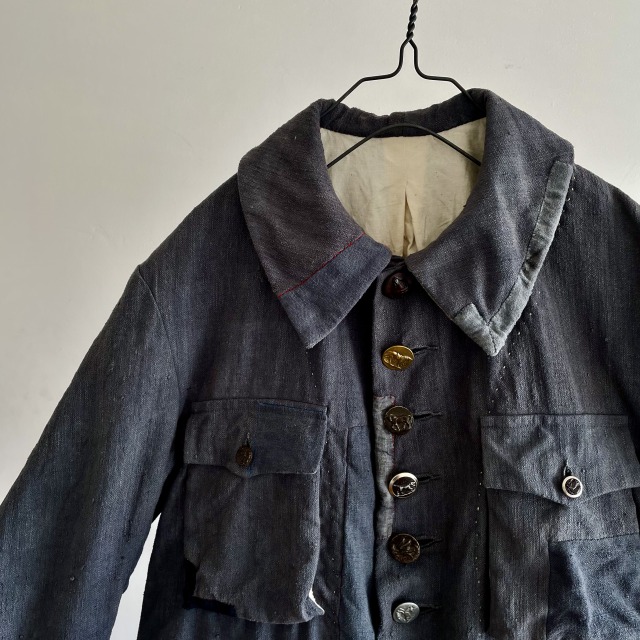

liningの取り付けと裾まわりの手の仕事。生地を丹念に縫い止めたステッチの手仕事ゆえの自然な乱れは豊かな趣を与える時間の結晶です。
Hand work on the lining and around the hem. The natural disorder of the stitches, which are painstakingly sewn into the fabric by hand, is the crystallization of time giving a rich flavor.


手仕事の温っぽさを打ち消した顔立ちが古いけれども新しい。
The face is old, but new, with the warmth of handwork canceled out.


Size 2
Shoulder width = 45cm
Bust = 55cm (underarm)
Sleeve length = 61cm
Dress length = 74cm
Made in France / Japan
Outer Fabric = Antique Natural Indigo & Iron-mordant Dyed Rustic Linen/ Linen100%
Lining Fabric = Indian Rustic Cotton Broad Cloth / Cotton 100%
Button = Vintage Animal Relief Button (Random Choice)
& Antique Fabric Covered Button
STOREへのリンク
[STANDARD By Manure of Drawers] SOLD



